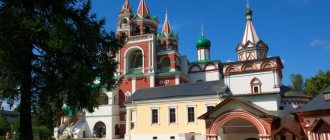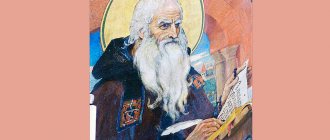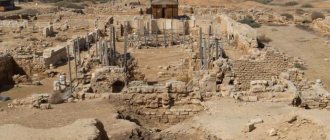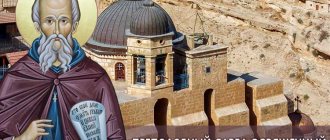| St. Job Pochaevsky |
Job of Pochaev
(c. 1551 - 1651), abbot, reverend Memory May 6 on the day of the namesake in monasticism [1], August 28 on the day of the discovery of relics, October 28, in the Cathedrals of Volyn and Galician (Lviv) saints
In the world, John Iron, was born around 1551 in Pokuttya in Galicia. At the age of 10, he came to the Ugornitsky Transfiguration Monastery, and in the 12th year of his life he accepted monasticism with the name of Job, upon reaching the age of perfection, that is, thirty years, he was elevated to the priesthood, and after a short time he was awarded the great schema, and he was The name John was returned. He especially loved this name and always signed himself with it, although he was canonized with the name Job.
Soon, at the request of Prince Ostrozhsky, he was transferred to the Dubno Holy Cross Monastery, which was in his possession, where he became abbot and ruled the monastery for more than 20 years in an environment of growing persecution of Orthodoxy by Roman Catholics and Uniates. He wrote a lot in defense of Orthodoxy.
At the beginning of the 17th century, the monk retired to Pochaevskaya Mountain and settled in a cave not far from the ancient Assumption Monastery. Having fallen in love with the holy hermit, the monks chose him as their abbot.
One day, arriving at the monastery threshing floor at night, he saw a thief who wanted to put a sack of grain on his back. The monk helped him lift this sack, but reminded him of the answer at the terrible Judgment of Christ. Shocked by the saint’s brief word, the sinner fell at his feet begging for forgiveness.
At the monastery of St. Job introduced communal regulations. He surrounded the monastery with a fence with the help of pious landowners Theodore and Eva Domashevsky and erected the Holy Trinity Cathedral, and then six more smaller churches. Zealously fulfilling the position of abbot, he was meek and affectionate with his brothers, he worked a lot himself, planted trees in the garden, strengthened the dams near the monastery.
He created the Pochaev printing house and continued to write in defense of Orthodoxy. One of his books has survived under the title “The Book of Job Iron, Abbot of Pochaev, written by his powerful hand.” In 1889 it was published under the title “Pochaev Bee”. Printing house Rev. Job, renewed at the beginning of the century by Archimandrite Vitaly (Maksimenko), was taken abroad by him after the Russian Revolution and now continues to exist in America, in the Jordanville Trinity Monastery, serving the spiritual needs of the Russian emigration.
The heir of Anna Goyskaya, the Lutheran Firlei, brought St. Job many sorrows. He took possession of the monastery lands and even the miraculous icon. But the holy icon was returned to the monastery after Firlei’s wife suffered God’s punishment for blasphemy against her, and the lands were returned by court shortly before the death of the saint.
In 1628 he took part in the Kiev Council, which condemned the union and decided to stand firmly for Orthodoxy. Under this decree there is a signature: “Ioann Zhelezo, Abbot of Pochaevsky.”
Sometimes he completely secluded himself in a cave for three days or a whole week. The Jesus Prayer was the constant work of his meek heart. According to the testimony of Dositheus, a disciple and compiler of the life of the Monk Job, one day during the saint’s prayer, a heavenly light shone into the cave.
He died on October 28, 1651 after fifty years of managing the Pochaev monastery, having lived just over 100 years.
Relics and veneration
His relics were discovered by Metropolitan Dionysius of Kyiv and Archimandrite Theophan (Krekhovetsky) and his brethren on August 8, 1659, after his appearance to the metropolitan three times. On August 28 of the same year the glorification of the Monk Job took place.
Soon after this, Eva Domashevskaya came to the monastery for a pilgrimage. At night, she saw a light shining in Trinity Church and heard singing. Her servant, the maiden Anna, went to find out what kind of service was being performed, and to her horror she saw that the church doors were open, and in the middle of the church, between two angels, the Monk Job was praying in an unusually light robe. Turning to the girl, he ordered her to call Abbot Dositheus, who was hopelessly ill at that time, and gave her a cloth for him, dipped in myrrh. The sick man, having received this cloth, anointed himself with it and received healing.
At the beginning of the 18th century, the Pochaev Monastery was taken over by the Uniates. They honored the miraculous icon of the Mother of God, but they closed access to the relics of the saint to believers. However, after 20 years, the saint’s miracles forced them to admit believers to them.
In 1831, the Uniates were reunited with the Orthodox Church, after which on August 28, 1833, the relics of St. Job were re-examined and solemnly opened for public worship. In 1902, the Holy Synod determined on this day to carry the holy relics of St. Job around the Assumption Cathedral of the Pochaev Lavra after the Divine Liturgy.
Iron standing of St. Job of Pochaev
Venerable Job of Pochaev
The lands of the northern Ternopil region had their own famous monk, who unwaveringly stood against the union as against apostasy, against betrayal of Orthodoxy - a native of Kolomyia, Abbot Job of Pochaevsky (1551-1651), who lived for a hundred years and in the world bore the indestructible name John Iron.
On September 10 (August 28, Old Style), the discovery of the relics of this saint, who stood like an iron wall for Russian Orthodoxy, is celebrated. Let us not forget that the territory where present-day Western Ukraine is located adopted the so-called Union of Brest in 1596, which meant “the accession to the Roman Catholic Church of a number of bishops and dioceses of the Orthodox Kiev Metropolis (as part of the Patriarchate of Constantinople) led by Metropolitan of Kyiv Mikhail Ragoza , on the territory of the Polish-Lithuanian Commonwealth."
But the Monk Job of Pochaev, the abbot of the Pochaev Monastery, stood indestructibly in the faith, and, justifying his name, with iron firmness he fought against the Uniates who had departed from Orthodoxy under the patronage of the Pope. The Monk Job was strong in spirit and faith; it is no coincidence that today many people from all over the Russian World flock to his holy relics, buried in a shrine near the cave where he prayed on Pochaevskaya Mountain.
And for the Uniates (Greek Catholics) - just like then, more than four hundred years ago, and now - don’t put your finger in their mouth. Not only did they, starting in 1991, seize churches and parishes of our canonical Church, which after the fateful Kharkov Bishops' Council in 1992 became known as the Ukrainian Orthodox Church of the Moscow Patriarchate, but also unprecedentedly, for the first time in history, during the reign of President Viktor Yushchenko , built their cathedral on the left bank of the Dnieper, in Darnitsa. Nowadays, they actively carried out their “prayer actions” on the “Euromaidan”, even to the point of calling on some Uniate “priests” to kill “Muscovites”, “commies” and others. It seems that Greek Catholics perceived the neo-Nazi, neo-Bandera coup in Ukraine as their own, native, allowing them to sharply intensify their expansion into the east of Ukraine, into the territory of canonical Orthodoxy, where they had previously been only during the period of Nazi occupation.
* * *
There are no pious princes, noble nobles are scarce, everyone has turned away from Eastern Orthodoxy to the West, barely anyone is found in the Orthodox faith from the bad and not glorious
God was pleased to reveal this saint of His in Western Rus' at the hour of great and terrible trials that befell the Orthodox in those parts. Here is what Metropolitan Isaiah Kopinsky wrote to the Moscow Patriarch in 1632: “There are no pious princes, noble nobles are scarce, everyone has turned away from Eastern Orthodoxy to the West, barely anyone is found in piety and the Orthodox faith from the bad and not glorious.” It was they - “thin and not glorious” - peasants, artisans, merchants, and clergy who had to fight the influence of the Jesuits, who were especially active at that time. The spiritual core and symbol of this struggle was the abbot of the Pochaev monastery, the Monk Job.
The monk lived in difficult years for Russia, when on its western outskirts the Orthodox people of Volyn and Galicia were subjected to cruel church and political oppression by Polish-Lithuanian magnates. The Monk Job witnessed the Union of Brest and the unstoppable advance of Catholicism that followed, as well as the ever-increasing influence of Protestantism. Being the abbot of the monastery and enjoying enormous spiritual authority, the monk used all his capabilities to strengthen Orthodoxy and to combat heterodox and heretical influences on the people's consciousness.
* * *
Venerable Job of Pochaev
The future saint was born in Pokuttya in Galicia (now Lvov region, not far from the city of Kolomyia) into the pious family of Ivan and Agafya Zhelezo, who belonged to a noble family who remained faithful to Orthodoxy. According to the Life of the Saint, written by his disciple, the Venerable Dosifei, it is known that at the age of ten, Ivan, “deviating from the eyes of his beloved parents,” came to the Ugoretsky Spaso-Preobrazhensky Monastery in the Carpathians, where 2 years later he was invested with a small schema with the name of Job. Much later (obviously, shortly before his death, the exact date is unknown) he also accepted the great schema.
The prayerful feats and pious life of the ascetic did not hide from people. Fame about him spread widely throughout the region.
Nobles began to reach out to the monk, asking for spiritual guidance. He began to enjoy special trust and patronage of the famous defender of Orthodoxy, Prince Konstantin Ostrozhsky. Prince Konstantin turned to the abbot of the Ugornitsky Monastery with a request to release the Monk Job to his princely Dubensky Cross Monastery. The abbot agreed, and after some time Job was placed at the head of the Dubno brethren. He remained in the rank of abbot for more than twenty years; it was during that time that the conclusion of the Union of Brest and the subsequent oppression of the Orthodox began. Prince Constantine, under whose protection the Monk Job was, had enormous influence in Volhynia and enjoyed the respect of the Polish king Sigismund III and Pope Clement VIII. Therefore, the Uniates and Jesuits did not dare to interfere with the actions of the Dubno abbot.
With the blessing of the saint, in 1581-1582 the first printed Slavic Bible, known as the Ostrog Bible, was published in Ostrog
During his stay in Dubna, the saint began distributing Orthodox books. To this end, he encouraged some to engage in translation and copying of books. According to the testimony of his life, the monk himself took part in that work. With the blessing of the saint, in 1581-1582, Prince Konstantin published the first printed Slavic Bible in Ostrog, known to historians and literary scholars around the world as the Ostrog Bible.
The worries and worries associated with publishing works, as well as the hostility of the Latins, distracted Saint Job from monastic work. The monk was associated with the Dubensky Monastery for almost 20 years as abbot; nevertheless, burdened by the abbess, he left this monastery and around 1604, striving for hermitic deeds, he found refuge in a modest monastery nearby - on Mount Pochaevskaya, where numerous stewards of silence had long settled.
* * *
The Monk Job sought obscurity and freedom for prayer in the Pochaev monastery, but the monks, who soon sensed spiritual strength in the stranger, unanimously and with tears asked him to become their abbot. The saint was forced to yield, and soon, through his labors, the Pochaev Monastery strengthened its position and rose above other Western Russian monasteries. He began to enjoy material support from local nobles who avoided falling into the union. Thus, in 1649, at the expense of the landowners Theodore and Eva Domashevsky, a stone church in the Name of the Most Holy Trinity was built in the monastery, to which the imprint of the celibate Foot of the Mother of God and Her miraculous Pochaev Icon was transferred, imprinted in stone.
Pochaev Lavra on an old postcard
But disasters soon followed. In 1607, the Tatars attacked the monastery and, having robbed and killed one of the monks. In 1620, the grandson of Anna Goyskaya, Protestant Andrei Firley, decided to drive the monks away from Pochaevskaya Mountain, for which he took away their land and, breaking into the monastery with his servants, took away the miraculous icon. After this, the house of Firleya was beset by disasters and illnesses, which did not stop until the icon was returned to the monastery.
The miraculous icon of the Pochaev Mother of God
These events prompted the Monk Job to considerable vain labor. For several years he was forced to travel to courts and offices, until finally the litigation with Firlei was resolved in favor of the monastery.
As a result of enormous efforts, it was possible to dig a well on Pochaevskaya Mountain and thereby provide water to the monastery (the neighboring sources were selected by Firley).
The book publishing and literary activities of the saint became especially important for the strengthening of Orthodoxy in Volyn. At the beginning of the 17th century, only one Slavic printing house remained in this region - Pochaevskaya. This is what the monk used to combat heterodoxy. Books of an accusatory and dogmatic nature, Orthodox prayers, and messages that were especially important in the conditions of Catholic expansion in Western Rus' were published here.
For many years (until 1932!) the Pochaev Monastery kept the work of the venerable man himself, “The Book of Blessed Job of Pochaev, written by his authoritative hand,” containing up to 80 conversations, teachings, sermons, as well as extracts from patristic, ascetic and polemical works ( published in 1884 in Kiev in Russian under the title “The Pochaevskaya Bee”).
The main thing for the holy elder was the fight against Catholics and Protestant sectarians. The monk was present at the Kiev Council of 1628, which took place in connection with the return to Orthodoxy of Archbishop Meletius Smotrytsky, who had fallen into the union. It was the Monk Job who wrote the conciliar definition, testifying to fidelity to Eastern Orthodoxy.
* * *
Along with his visible labors, the invisible prayer life of the saint also took place. The monk Job found the loneliness he so sought in a wild cave on Mount Pochaevskaya. This cave was very narrow and tiny, in it they shed many heartfelt tears “for a world lying in evil,” as the Monk Dosifei put it in the life of the saint.
Once, when the monk was praying in a cave, “an extraordinary light suddenly illuminated his cave and for two hours was reflected from its depths...”
The monk sometimes retired to it for a whole week, where he prayed for peace in strict fasting. (“In a narrow cave of stones, for the sake of thought and prayer, you were often confined,” says the troparion of the 4th tone to the Monk Job). What happened in those hours in this cave is not given to any mortal to know, but one day, when the monk was praying in it, “an extraordinary light suddenly illuminated his cave and for two hours was reflected from its depths on the opposite church.”
Whoever was honored to visit the temple cave of the Pochaev monastery, where the relics of the two pillars of Pochaev - the Venerable Job and Amphilochius - rest in crayfish, remembers the reverence that covers you when you “lean” with your heart and soul to this place, to the honest relics of the spirit-bearing elders who stood with a difference in more than three centuries on the spiritual boundaries of Orthodox Rus'. The famous Russian church writer and pilgrim A.N. Muravyov rightly noted (these days mark the 140th anniversary of his death), the original history of Mount Pochaevskaya should be sought “not at the height of the rock,” but in the depths of its caves.
The hands of the saint, incorruptible and deceased many centuries ago, are still warm and soft today, like those of a living person. And they exude a wonderful aroma
The relics of St. Job rest with great honor and great care. A wonderfully decorated shrine with the relics of the Monk Job is placed in a natural cave, next to the hole into the saint’s cave, where he spent so many hours and days in prayer vigil. Powerful stone vaults made of gray untreated stone in the cave, right there is a small rich iconostasis, lamps, candles and the relics of a saint. The relics are hidden in glass, but not completely. The hands of the incorruptible relics are open and applied to them as to the hand of a living righteous person. The hands of the saint, incorruptible and deceased many centuries ago, are still warm and soft today, like those of a living person. And they exude a wonderful aroma.
Those who wish can climb up and pray in the saint’s cave. Oral rumor ascribes to this hole the wonderful ability to freely let through people who are pure in heart, humble, and repentant, but it “grabs” the unrepentant and does not let go until they repent in front of everyone.
The feeling in the prayer cave of St. Job is as if you have fallen into the right hand of the Lord
Anyone who dived (that is, dived, head first and down!) into a very tiny “pecherka”, into a small hole in the rock, which seems to be almost the size of two fists, will never forget this. At first, you don’t even understand how an adult can slip through there. But you try, and you squeeze through into complete darkness. Your breathing is interrupted, your chest contracts as you crawl into the darkness, your heart is pounding from the unknown, as if it wants to jump out. There is an invisible servant supporting you within. You found the icon, touched it with your lips, with difficulty collected yourself and read three prayers. The feeling in the prayer cave of St. Job is as if you fell into the right hand of the Lord, it squeezed you like a piece of cheese, squeezed out everything unnecessary, and again returns you to the real world. A direct, complete, clear feeling that you are before the Face of the Lord.
* * *
In addition to prayer and contemplation of God, the monk also engaged in physical labor. He worked in the monastery garden, with his participation two ponds were dug near the monastery and dams were made.
During the period of military actions of Bohdan Khmelnitsky against the Polish-Lithuanian Commonwealth, the Monk Job gave many people refuge in his monastery. It is also known that the monk was chosen as their confessor by many influential people of that time. Until 1649, the Monk Job served as abbot, and appointed himself a successor only at the age of 98, but even after that he participated in the most important affairs of the monastery.
On October 21, 1651, the saint received a revelation about his imminent death. On October 28, after performing the Divine Liturgy, he peacefully departed to the Lord. The monk was buried near the cave where he asceticised. A wonderful light was often seen over his grave. Seven years after his death, Saint Job appeared three times in a dream to Metropolitan Dionysius (Balaban) of Kyiv and informed him that the time had come to reveal his relics.
His body lay in the ground for seven years and 9 months after burial. The discovery of the honorable relics took place as follows: on August 28, 1659, Metropolitan Dionysius led the solemn discovery of the incorruptible relics (“without any decay, as if buried at the same hour, and filled with a misunderstood fragrance”) of the monk, on which even ulcers on the legs remained noticeable after swelling from a long prayer standing. The life of St. Job says almost nothing about these plagues. But it is very likely that the saint’s adoption of the name Job in honor of the righteous Job the Long-Suffering, which he bore while in the minor schema, is directly related precisely to the reverend’s greatest patience with many illnesses, while he observed the deepest humility and stylite standing in prayer.
At the same time, the incorrupt remains of the Monk Job were transferred to the Church of the Life-Giving Trinity.
Many miracles happened from them, for example, the terminally ill Dositheos, the writer of the saint’s life, received healing. In 1675, through the prayer of the saint, the Mother of God saved the Pochaev monastery from the Tatars and Turks who besieged it. The Most Holy Theotokos appeared over Mount Pochaev together with Saint Job; the arrows sent at Her by enemies returned and struck those who launched them. The Muslims fled from the horror of the miracle.
At the beginning of the 18th century, the Pochaev monastery went to the Uniates. But miracles and healings from the relics of St. Job did not stop. And even the Uniates believed in the holiness of the saint, composed a service for him with an akathist and began to ask the Pope to canonize Job. What they were denied because of the saint’s zeal for Orthodoxy.
In 1831, the Pochaev monastery again returned to the jurisdiction of the Russian Church. The miraculous healings from the relics of the saint prompted the Holy Synod to open them a second time, which was done on August 28, 1833. Let us pay attention to the coincidence of the dates of the first and second acquisitions-discoveries.
Reliquary with the relics of St. Job of Pochaevsky in the cave church of Job of Pochaevsky
In 1858, on the site of the cave church, a new temple was built in the name of St. Job.
The Akathist to the Monk Job reads: “O all-blessed and God-bearing Father Job, God-wise mentor of the monastic angelic life, invincible defender and champion of the Orthodox Eastern Catholic faith against the false wisdom of the West, of the God-given statutes of the Church and the traditions of the fathers, faithful guardian and strict enforcer, holiness and purity, chastity Riya and non-covetousness, hard work and thought of God, fasting and vigil, a great zealot, long-suffering and suffering, a tireless and invincible warrior, an image of meekness, a mirror of humility, an example of gentleness, fertilizer for fasters, praise for virgins, joy for monks and schema-monks... Protect us with your prayers from all slander of the enemy and evil circumstances, preserving and keeping each and every one in peace and silence, in unhypocritical faith and godly living.”
To this day, the Pochaev monastery stands as a stronghold of Russian Orthodoxy among lands constantly subject to Greek Catholic invasion, and does not surrender
The Pochaevsky Holy Dormition Monastery received the status of Lavra much later than the sacred struggle of the Monk Job. To this day, the Pochaev monastery stands as a stronghold of Russian Orthodoxy among lands constantly subject to Greek Catholic invasion, and does not surrender. We should all learn the steadfastness and indestructibility laid down in the basis of this standing by John Iron.
Reverend Job, pray to God for us!
Prayers
Troparion, tone 4
Having acquired long-suffering forbearance from the long-suffering forefather, / resembling the baptismal abstinence, / sharing both divine zeal, / you were worthy to receive those names, / and you were a fearless preacher of the true faith; / you also led many monks to Christ, / and you established all people in Orthodoxy ,/ Reverend Job our Father,/ pray for our souls to be saved
.
Troparion for the Finding of Relics, Tone 4
Lay the yoke of Christ on this from your youth, O Reverend Father Job, / for many years you labored holyly / in the field of piety in the monastery of the Ugornitsy and on the island of Dubenstem, / and, coming to Mount Pochaevstey, / marked by the celibate foot of the Most Holy Theotokos, / in a cramped stone cave / for the sake of the thought of God and prayer, you have repeatedly concluded, / and, strengthened by the grace of God, / you have courageously labored / for the benefit of the Church of Christ and your monastery, / and also against the enemies of Orthodoxy and Christian piety, / and, having instructed the militia of the monastic, / the winners of those presented you to the Master and God. / Pray for the salvation of our souls
.
He entered a monastery... at the age of 10
The Monk Job of Pochaev was born around 1551 in Western Ukraine, on the territory of Galicia. Today this is the village of Ugorniki, Kolomyia district, Ivano-Frankivsk region. His parents were deeply religious; they named their son Ivan - in memory of John the Baptist.
When the boy was only 10 years old, he secretly left home for the Ugornitsky Monastery. We have not heard stories about how parents were looking for their son, and the abbot of the monastery did not let the boy in without the consent of his father and mother. On the contrary: everyone saw the will of God in what happened, and the abbot was able to discern a future ascetic in Ivan.
Two years later, the boy was tonsured as a monk with the name Job - in memory of the Old Testament righteous man Job the Long-Suffering.
For a modern person, it seems very strange how a 12-year-old boy can be a “real monk.” But this is precisely what Job Pochaevsky was, spiritually mature beyond his years.
At the age of 30 he was tonsured into the great schema. Skhemniki, in a sense, are the highest degree of monasticism. Those who have accepted the schema are freed from all obediences, except for serving the Liturgy and clergy. Schemamonks live in solitude and devote all possible time to prayer. The monk lived in such spiritual feat for 70 years.
It is also interesting that during his tonsure into the schema he was again given the name John, but he entered the church calendar precisely as Job.
Dubensky Monastery and test of faith
This was a difficult time for the Orthodox Church; due to the difficult political situation, Western Ukraine was increasingly drawn into the union. In 1596, as a compromise, the Greek Catholic Church arose, preserving the Orthodox rite, but accepting the main Catholic dogmas and submitting to the Pope.
Even when many intelligent people of that time accepted Uniatism, Job Pochaevsky firmly defended Orthodoxy. Iron, indicated his hardness .
Since 1580, at the numerous requests of Prince Konstantin of Ostrog, the monk moved to the Dubensky Cross Monastery.
Here, through their common efforts - the prince and the monk - a circle of spiritual enlightenment and firm standing in Orthodoxy is formed. Job supports educational activities. With his blessing, in 1581, Ivan Fedorov published the Ostrog Bible, and through the efforts of the monk, the works of the Church Fathers were translated at the monastery.
In a short time, Job became a famous person:
- the fame of a monk, ascetic and educator spread about him;
- Because of his educational activities, there is growing dissatisfaction on the part of those who converted to Catholicism or a more compromise union.
In this situation, Job Pochaevsky decides to retire somewhere near Pochaevskaya Mountain. But he was unable to completely retire. After some time, the Pochaev monks found him and invited him to become their abbot.
Hegumen Pochaevsky
During the reign of Job, a communal charter was established in the monastery, the Holy Trinity Cathedral and six churches were built. The abbot did not forget about his educational activities, as well as his schema vows.
Many sources indicate that in 1626 the monk created a printing house at the monastery, and also wrote a fair number of essays in defense of the Orthodox faith. He was the author of the “Book of Job Iron, Abbot of Pochaev, written by his powerful hand.” The work was published almost 200 years later under a different title (“Pochaevskaya Bee”).
Cave of Saint Job
Job Pochaevsky spent almost all his time in solitude. Today, everyone who comes to the Pochaev Lavra can see the saint’s cave. Some pilgrims are even afraid to climb there: it is cramped, humid and uncomfortable. But this did not frighten Saint Job at all: he spent whole hours on his knees and prayed. As his biographer, monk Dionysius, writes, this caused the saint’s legs to hurt and become covered with bloody wounds. But the pain did not stop the ascetic.
Divine Light
One of the saint’s disciples saw how the saint’s body shone with an unearthly light. So at one time Seraphim of Sarov had an epiphany before Motovilov. This is how Sergius of Radonezh shone after meeting the Mother of God. This is probably how Christ shone on the day of transfiguration. This is an unearthly light, and we are all called to it. Job Pochaevsky was awarded it already on earth.
Imperishable relics
The body of the saint, touched by God's grace, remained incorrupt even after death. And the saint died in 1651, at the age of 100 years. Neither constant fasting, nor bloody scabs on his legs, nor meager food undermined his physical and mental health. The test of time has not affected his imperishable relics. After all, holiness is not subject to earthly laws.








